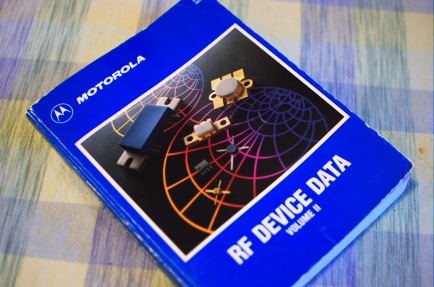Author Archive
 More on the TS-930S PA
More on the TS-930S PA
I’m not sure that I’ve shared this on the blog, but I’ve long known that the reason that my “troublesome” 930 burns up PA drivers is a low-frequency oscillation. This mechanism was also mentioned by Leeson in his comprehensive list of 930 upgrades and repairs. At first, I thought that the 28-volt power supply’s filter capacitors might be the culprit—insufficient ripple-suppression. After all, the oscillation sounds like it has a 60-Hz component (I’ve never tried to measure this because I’m concerned about blowing up more transistors). I finally completed the capacitor replacement last night, realigned the power supply voltage and PA bias levels…and the oscillation is still there, just as I increase the drive past the point where I get 50 watts out.
There is a good Helge Granberg article in the September/October 1980 issue of RF Design titled “Good RF Construction Practices and Techniques.” I would like to get a copy of the original article because Motorola, in their infinite wisdom, reprinted the article as AR164 but neglected to include the list of references. Granberg devotes an entire section of the article to instabilities, a full of half of that section to low-frequency instabilities. This is the area I will focus on first:
Causes for the low frequency instability are usually inadequate collector DC feed bypassing or an extremely poor ground in that area. Two or three RF chokes together with various values of bypass capacitors from 1000 pF to several uF may be required in the DC line to stabilize the circuit. (See examples in Reference 1.)
Ah, Reference 1, where (who) art thou?
If I ever get to the bottom of this problem, there should be a useful body of work and notes to prevent this from happening repeatedly to others.
 A License to …
A License to …
Jeff, KE9V, posted a note today about all of the bellyaching that goes on over the Hamvention venue at Hara Arena in Dayton, Ohio, also occasional home to Bill Goodman’s North American Gun and Knife Show (“Tell a buddy, bring a friend…Don’t you dare miss it!” the jingle goes). In fact, according to the Hara calendar, it appears to host almost monthly gun and knife shows. But, I digress. I’m delighted that Hara is near my in-laws’ home should I ever wish to make a last-minute appearance—yes, it’s tempting to get in the car tonight. And, I digress farther. The point of this post is to explain the pervasive grumbling, finger-pointing, and misinformation, that spews forth from a vocal minority of the amateur community.
I was sitting in 8th grade math class adrift in daydreams as the teacher reviewed yet another topic from a prior grade. Clearly, this was a widely-perceived problem, because one of my classmates persisted in talking to several others around her. Finally, the teacher became so exasperated that he asked, “Young lady, do you have a license to talk?” Of course she did not, but I chuckled noting that, as a newly-minted General class amateur radio operator, I had a license to talk. I tucked that away for future use and went back to whatever it was I was daydreaming about. And today, some 16 years later, the thought sprung into my mind as I read Jeff’s blog.
Another curious coincidence contributed to this confluence of cogitation. As I was eating my lunch, I happened across an old KK7B paper from the Proceedings of Microwave Update ‘94 entitled “Simply Getting on the Air from DC to Daylight.” It’s not a particularly technical paper. It is about the art of doing radio and it was fun to read. In the first three paragraphs, he writes,
In the not-so-distant past, the primary emphasis in amateur radio was putting a station on the air…Sometime in the ’70s the ARRL stopped calling amateur radio a technical hobby and started referring to it as a communications hobby.
Brilliant. I’d like to update that for the present,
In the not-so-distant past, the primary emphasis in amateur radio was communication via radio…Sometime in the ’00s, realizing that it had lost the communications game to telecom deregulation, mobile phones, and the Internet, the ARRL stopped calling amateur radio a communications hobby and started referring to it as an emergency service.
So, where does that leave us? Well, we have a technical license exam structure impressed upon a group of people who are enthralled with communication but use the Internet because it’s easier. No wonder anybody who reads about ham radio on the Internet thinks we’re up a creek!
I’m going to go make a CW contact or melt some solder to cheer myself up. In the end, we have a license to communicate via radio. Let’s use it.












